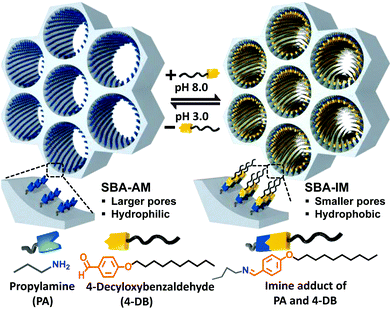
Reversible engineering of the pore size and philicity of mesoporous SBA via dynamic covalent chemistry triggered by changes in pH.
Control of surface chemistry is important for utilisation of mesoporous silicas in many applications such as catalysis, drug delivery and separation sciences. Due to the mostly irreversible nature of covalent functionalisations and lack of rigidity in supramolecular approaches, in this study, dynamic covalent chemistry was used to reversibly alter the chemical coating on the surface of amine functional mesoporous silica SBA-15. This was achieved through the condensation reaction of the primary amine on SBA-15 with 4-decyloxybenzaldehyde (4-DB) to form an imine containing a hydrophobic decyl chain. This step both reduced the pore size and hydrophilicity of the pore surface, however, could be reversed by cleaving the imine at low pH in an ethanol/water mixture.
Dynamic control of the pore properties was demonstrated using the catalytic reduction of p-nitrophenol in aqueous conditions by gold nanoparticles, which were imbedded into both amine and imine/decyl SBA-15 materials. The more porous/hydrophilic amine-based material completely reduced p-nitrophenol to p-aminophenol after 30 minutes, whereas the more hydrophobic imine-based surface exhibited no catalytic activity. The authors suggest that this methodology could be used to generate a host of new covalently functionalised materials with tuneable surface properties.
Reversible control of pore size and surface chemistry of mesoporous silica through dynamic covalent chemistry: philicity mediated catalysis
Dheeraj Kumar Singh, B. V. V. S. Pavan Kumar and M. Eswaramoorthy
Nanoscale, 2015, Advance Article. DOI: 10.1039/C5NR02959G
Dr Mike Barrow is a guest web writer for the Nanoscale blog. He currently works as a Postdoctoral Researcher at the University of Liverpool.










